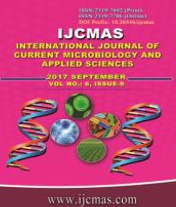


 National Academy of Agricultural Sciences (NAAS)
National Academy of Agricultural Sciences (NAAS)

|
PRINT ISSN : 2319-7692
Online ISSN : 2319-7706 Issues : 12 per year Publisher : Excellent Publishers Email : editorijcmas@gmail.com / submit@ijcmas.com Editor-in-chief: Dr.M.Prakash Index Copernicus ICV 2018: 95.39 NAAS RATING 2020: 5.38 |
Typhoid fever is an important public health problem. According to a press release from the Press Information Bureau, Government of India, dated 22 February 2006, the morbidity due to typhoid fever varies from 102 to 2,219 per 100,000 population in different parts of India, and in some areas, typhoid fever is responsible for 2 to 5% of all deaths. Gold standard for diagnosis of typhoid fever is blood culture, but it is time-consuming and takes several days for isolation and identification of causative organisms. Serological tests have very low sensitivity and specificity, and of little practical value in endemic areas. However for optimal management, early diagnosis of the disease and prompt treatment are essential. Therefore a rapid and sensitive detection method for typhoid fever is urgently needed. Method Blood sample was taken from 100 suspected typhoid cases for conventional blood culture, BACTEC blood culture and real time PCR. Blood culture was performed using standard protocol. real time PCR targeting the prg K gene was performed on all the 100 samples. Results: Out of 100 suspected typhoid cases blood culture and Bactec were positive in 24 cases. There were no differences in yield of Conventional and Bactec blood cultures. The Real time assay identified 20 cases (83%) as positives among the 24 culture positive cases. However, the assay additionally detected 20 (26%) of cases as Salmonella infections among culture negative patients. The sensitivity and specificity of Real Time PCR assay was determined to be 83.33% and 73.68% using blood culture as gold standard. . Conclusion It is thus concluded that PCR is a rapid, sensitive, and specific test for the diagnosis of typhoid fever, especially where blood culture was negative because of prior antibiotic treatment and culture done in late stages of disease, thus enabling the clinician to use appropriate treatment and to avoid diagnostic delay
 |
 |
 |
 |
 |